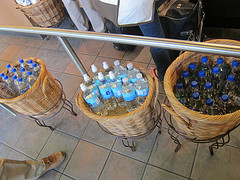
Time after time, we start research all sorts of gadgets, from technology to productivity tools to…well, home tech.
This week, we are talking about water filtration filters. Many people buy bottled water. We’re not sure why they do this. Some bottled water is actually tap water. Tap water is actually more regulated than bottled water.
Bottled water isn’t a good value. The cost per bottle is significantly higher than a that of tap water. Bottled water actually has a higher per gallon markup than gasoline, and takes substantially fewer resources to produce. And it must be stored in bottles. which are estimated to total 1.5 million tons of plastic waste each year.
If you don’t like the taste of the local water supply, that is what filtering is for. If you are concerned about contaminants, that is what water filtration is for. Assuming you get water from your municipal water service, this water is already treated to a degree, but filtering in the house can give you a better experience.
Home water filtration began to become popular with the pitcher filter. The quality levels of these can vary, but a single pitcher is usually not enough water for a whole family. We migrated from this to the faucet filter. In edition to not being aesthetically pleasing, these filters can slow water flow significantly.
We chose to go with the under-sink filtration option. The first problem with these filters is that they require, if not a plumber, someone who feels comfortable with plumbing. You can either filter the cold water running through your faucet, or add a dedicated spigot, which may require drilling a hole. Our sink already had a cutout, so we went for the spigot option.
In reading review after review of these types of systems, the most common issues stem from installation. The systems leak, sometimes because of improper installation and because many manufacturers include cheaper plastic parts instead of heavier duty fittings and piping. For this reason, we brought in a plumber to do the job, and empowered and encouraged him to replace all parts in the box with more secure fittings, and to add an extra shutoff valve in the event there was a leak. This may be overkill, but the last time we had a leak under our sink, it turned into a mold issue.
This is probably the best lesson we can give about these filters. Go to your local hardware store and buy better quality fittings than any of these filters supply. The price shouldn’t add much to the bottom line. And add an extra shutoff valve, which will assist when you replace your filters, if nothing else. The cost of a valve is minimal.
There are two other types of filters we didn’t mention. A whole-house filter can remove some basic contaminants, such as sediment and rust, and are probably better if you have a more serious issue with these contaminants. Reverse osmosis filters use a tank under the sink as well as filters, and are the only type that can remove arsenic. However, they are slow, take up a lot of space and waste a lot of water.
We opted for a lesser known brand, but well thought of brand, based on a combination of reviews and research.
[asa]B002XISS2Y[/asa]
The above is a three-stage filter. The price was reasonable compared to most two-stage filters, and the mail-order price for a years supply of filters was reasonable. It contains no electronic filter change reminder, so we added a recurring reminder to Google Calendar.
The same company does offer a 1 and 2 stage filter as well, but with the installation effort being equal, we opted for the best decision long-term. You will probably be served reasonably well by filters from a variety of different companies, but do your research.
[asa]B0018MXH04[/asa]
[asa]B0018MVZJE[/asa]
